September 21st, 2010 · 1 Comment
Museums in England and unlike any I’ve seen before. It’s absolutely incredible. I can’t believe how trusting the curators are. There will be an ancient Greek sculpture, for example- the original, mind you- on display with no barrier separating it from the museum-goers. There will simply be a sign nearby asking politely if the spectators please wouldn’t mind not touching it. At the Victoria and Albert, you can accidentally lean against some medieval sarcophagus without even realizing it.
Another amazing thing about the museums here is the wide variety of objects on display. I speak mostly of, again, the Victoria and Albert, where everything is wonderful yet nothing really seems to make sense. There are gigantic rooms filled with hundreds of objects, none of which really seem to fit into the same category. There is a Japanese teahouse in the medieval section, for example. In the fashion exhibit, hundreds of outfits were organized, almost nonsensically. At first, I thought they were chronological, and then I thought they were organized by the fashion capital they were designed in. Eventually I realized that both categorizing systems were incorporated into the design, but neither permeated the entire exhibit. The result was a very interesting yet scattered display.
The “Recent Acquisitions” room was my favorite. It was located off a hall that was filled with ancient Asian artifacts and next door to a room that contained miniature models of the V&A museum. The recent acquisitions apparently consisted of something like a ball of yarn, a strangely painted chair, and an ancient statue. They had absolutely nothing in common except for the fact that the museum had recently acquired them and did not yet know where to put them.
There were two large rooms- which were not available for viewing but were located underneath a walkway so we could see into them- that were filled with huge replicas of columns and gargantuan doors and enormous shrines. I could see no rhyme or reason to the organization of these rooms- they seemed more like storage areas than anything else- but they were beautiful and fantastic, nonetheless.
The organization of the rooms was so strange that it was rather difficult to find anything. This made it enjoyable in the sense that it made the museum visit seem almost like a treasure hunt; it made me look at things more carefully, to ensure I didn’t miss out on any exciting artifacts. I managed to find, courtesy of Amy, one of da Vinci’s note books tucked behind a wall, nearly hidden from sight in the Medieval and Renaissance section. The Hypnertotomachia Poliphili, a beautiful book from the 1400s, was practically stashed away in a drawer in the same area. In the Theatre section, I was able to see, amongst a vast collection of current movie posters and sketches of older plays, two patents for theatres from 1660 scattered throughout the less significant pieces.
Of course, not all museums in London are organized like the V&A. The British Museum and both the London Museum and the Docklands Museum, for example, are organized very logically. It is not hard, in these museums, to see why the curators arranged the exhibits the way they did.
But I am very curious as to why the V&A is organized as it is and, sadly, I do not have an answer. Perhaps there are just too many items from a broad variety of periods to be contained by conventional categorization. Or perhaps the curator just thought it would be an interesting display. My speculation will have to do for now, I suppose.
Tags: 2010 Jessica
September 21st, 2010 · 1 Comment
I’m not much of a history freak, but I think museums are amazing. They serve as a unique interactive learning experience allowing us to actually see and absorb things that we wouldn’t obtain through a textbook or classroom lecture. Seeing artifacts and paintings brings history to life, and this method of learning is preferable by some people and especially for young children for the hands- on experience. It is really cool to be able to walk into a museum, and in London’s case for free, and see something that existed millions of years ago. I’ve always admired to determination of historians to seek the unknown, and figure out when and why something happened, and to openly share this information with the public.
One of my favorite museum trips was earlier on in the month when we visited the Museum of London. I always knew about the Romans, and read about the founding of London and Britain as an empire, but actually physically seeing everything connected all of the random pieces of information in my head. I enjoyed learning about early Roman life, and realizing that we learned cleanliness from them. The women made hair combs, nail clippers, and even tweezers that so closely resemble the beauty essentials women use today. I loved that each floor uncovered different eras of London’s history, which included industrialization, political and social movements, and even fashion.
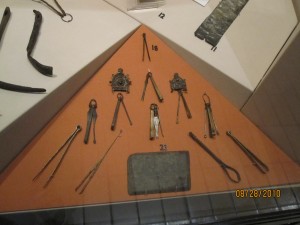
(Roman beauty essentials)
Another one of my favorite museums was the Victoria and Albert museum. Many students disliked this museum the most because it was too hard to navigate, but I actually appreciated the arbitrariness. I was so bored of visiting museums that solely displayed the rich white royalty of England, that is was nice to have a change with something that was completely informal and unplanned. Stumbling room by room through this organized chaos, I realized you could find just about anything in this museum. I was able to admire the fashion styles of Grace Kelly and to jealously look at centuries worth of jewelry worn by generations of rich people.
There were artifacts and sculptures thrown everywhere, it was like a giant garage sale. In the section with mosaics and paintings, we found a mosaic of Rome by Antonio Testa that took him twenty years to complete. This museum was filled with thousands of artifacts, my only question is where did they get all of this stuff from? I was trying to think of a coherent way that they could have organized everything, but honestly it would be impossible. So whether the designer just gave up on figuring out a floor plan, or intended it to be this way, I really enjoyed it.
Tags: 2010 Melissa · Uncategorized
September 21st, 2010 · 1 Comment
It seems like everyone I talked to in our program strongly disliked the Victoria and Albert Museum. I don’t know what they were thinking, because I thought it was one of the most amazing places I have ever been. I loved how random it was – it really epitomized British eccentricity. The V & A seemed to be completely lacking in order from one room to the next, whereas other museums that we have been to, like the British Museum or the London Museum seem to be arranged more logically. But I really like how chaotic it was. It added the element of surprise which made me laugh aloud. I think the key is to go in with a game plan. Know which exhibits you want to see beforehand, that way you organize your visit accordingly. Any interesting sites you find along the way can just be a fun little bonus.
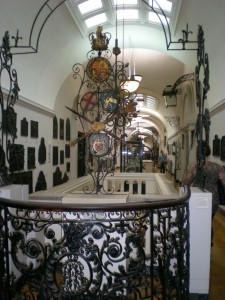
So what was the most interesting part of such a fascinatingly bizarre place? No, not the jewelry, although my eyes were glued to several dazzling tiaras, but what I found most intriguing was being able to watch the museum staff put together an exhibit. I felt like I was backstage at a play, watching the people who work behind the scenes. I never realized how much work it would take to create even just one exhibit. There were at least ten or fifteen people working on the room. Some were doing physical work, lifting and moving planks of wood, while others looked over papers on clipboards and directed traffic. However, I was a bit mystified because I didn’t know what it was exactly that they were building and I still don’t know what it had to do with that particular room of the museum. It just looked like they were plonking down a big ol’ wall in the middle of the room. And as far as I could tell there were no signs posted anywhere with “coming soon” information, so I’ll just have to make another trip back to London in a few months to see what it looks like.
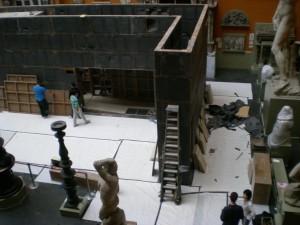
I also got really excited when I saw the piece by Dale Chihuly. The artist is known for his work with glass, creating huge and intricate structures. I was fortunate enough to be able to see his exhibit back home at the Botanical Gardens in New York with my family, and so when I recognized his work in the V&A, it was like seeing a little piece of home.

This is a piece at the Victoria and Albert Museum
Here’s one from home:
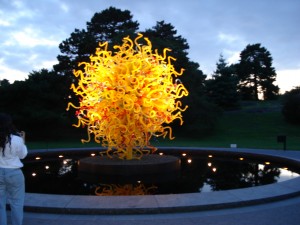
Tags: 2010 Sarah
September 14th, 2010 · 3 Comments
We’ve already talked about the elitism that we’ve seen in museums such as the National Portrait Gallery and the National Gallery, and I’m sure that everyone has at least a passing familiarity with the debate over the Elgin Marbles. (If not, Stephenie wrote a small book about it a few days ago, so just keep scrolling down the page.) I don’t want to beat the imperialism theme over the head too much, so I’ll try to take a different angle here. What has struck me about so many of the museums that we’ve visited has been the vast collections of stuff housed within their walls. Isn’t this the point of musuems? you might ask. Well, yes. But I feel like the size of the collections and the way that they are displayed here just screams “materialism” more loudly than any museum that I’ve visited previously.
Apart from the British Museum, the Victoria and Albert Museum is the best example of this. The array of exhibits in this museum is incredible–everything from fashion to theatre, jewelry, micromosaics, sculpture, medieval art, and every silver dish ever manufactured in the British Empire. Wandering through (the floor plan made absolutely no sense to me, so I just walked around), my eyes started to glaze over because of the sheer number of artifacts displayed. In the silver rooms, for instance, there were cases packed so tightly with pieces that there was not enough room for display cards; interested viewers had to pick up a card that was chained to the outside of the case. And underneath all of these cases, which took up a pretty substantial area, were drawers full of more pieces that didn’t fit in the displays. It was insane. The V&A had some amazing pieces, but the opulence and materialism on display there were astounding.
Although some of the other museums that I visited were much smaller and were actually house museums, I noticed this same glorification of materialism. The Sir John Soane Museum is a wonderfully eccentric home that Soane, a nineteenth-century architect, designed specifically to hold his collection of artifacts and his “cabinet of curiosities.” It’s really neat to walk through and see all of the peices that he has hiding in the nooks and crannies of his home (one room has extendable walls that fold out from the permanent walls. There are currently sketches by J.M.W. Turner that are displayed on these hidden walls). His collection includes several pieces of Greek and Roman statues, wonderful works of art by Hogarth and Canaletto, and even an Egyptian sarcophagus. But again, I got the sense that there were just so many things packed into such a small space. And I had to wonder, like Stephenie, how he came by all of these treasures and why he needed a room full of Roman busts. It seemed as though he had collected all of these things simply because he could. Thankfully he had the foresight to turn his home into a museum so that his collection would be accessible to the public to come and learn from it, but the thought still lingered. The Wallace Collection left a similar feeling, although a large portion of the collection housed there comes from other parts of Europe.
I firmly believe that these huge, opulent collections are only possible because of Britain’s imperial past. They had access to so much of the world, and they had the power and the weapons to take artifacts from all of these places (even if the Elgin Marbles were supposedly sold legally). As the strongest nation of the nineteenth century, Britain was able to amass all of the silver found in the Victoria and Albert Museum, and all of the pieces of sculpture housed in the Soane. The money was there and the artifacts were ripe for the taking, so materialism (and I think fascination with exotic cultures, especially with the Orient) naturally followed. I’m not trying to say that this is right or wrong, and Americans as a whole definitely value the consumer and material wealth. It’s just what has really struck me from the museums that I’ve visited.
Tags: 2010 Holly · Museums
September 6th, 2010 · 5 Comments
I visited the Tate Modern this week determined to disprove my growing suspicion that modern art is an Emperor’s New Clothes type hoax designed to make me look like an idiot. Unfortunately, the first time I visited I only had half an hour. So I rushed through a floor of splattered paint and a white room filled with off white canvases that, according to Agnes Martin, were supposed to represent “weightlessness and infinity” rather than the possibility that the museum staff had run out of white paint.
Then I came back a few days later when I had more time, and as luck would have it the first exhibit I came across was Art & Language by Michael Baldwin and Mel Ramsden with the promising description that “viewers are now confronted by themselves, thereby questioning a long-held notion of painting transcending reality.” I understand that some art is supposed to be philosophical, but it was a mirror on canvas, which makes it the exact equivalent of that scene in my favorite childhood movie, Neverending Story (costarring a delightful dragon puppet) in which the main character has to face himself in a metaphorical mirror to save the land of Fantasia. Obviously the best movie ever created, but not art. It made me angry.
So I went through the next few rooms with the mirror as a yardstick for my expectations and found the following pieces:
- Giuseppe Penone’s Tree in 12 Metres (two trees in a museum)
- Peter Fischli and David Weiss’s Untitled (some guy’s messy garage in a museum)
- Keith Arnatt’s Self Burial (a bunch of pictures time elapsed pictures of a guy sinking in quick sand)
I list these pieces because they were really underwhelming until I looked at them a second time, and they turned into basically the coolest things ever. The Tree in 12 Metres was actually two perfect trees shapes carved out of a giant block of wood. Every messy garage item was a replica carved, textured and painted with polyurethane foam and acrylic paint (this includes an old rubber tire, an unvarnished wooden bench with knots, and a bunch of other distinctly textured items). The time elapsed photographs interrupted a TV program once a day in sequence showing for 5 seconds without any explanation.

I’ve been seeing this pattern everywhere, and I feel like the British must have a huge penchant for Easter eggs. The Bloomsbury walk was covered in historical landmarks that I always thought were a huge deal. In the United States, Virginia Woolf’s house would at least be a small museum as opposed to the small plaque next to an otherwise occupied building. The Victoria and Albert Museum was a whole other level of hidden amazing things. Along with a novelty bustle that plays God Save the Queen every time the wearer sits down (classy), one of DaVinci’s notebooks, marked in tiny writing, was sitting in a random corner (The other five of his notebooks that the museum has are just in storage right now. No big deal). Do they just have so much history here that they have to ignore some of it so as not to turn the country into a museum? Or does that obsession with understatement that Kate Fox talks about seep itself all the way in British history so that they hide their great achievements in a corner out of amusement and feigned modesty? It seems so contradictory to what I would expect from a former empire. I expect neon signs. Not that I’m complaining. I don’t think I would get this excited about a foam tire replica under any other circumstances.
Tree of 12 Metres
(Giuseppe Penonoe) from Tate.org
Tags: 2010 Jesse
September 15th, 2009 · No Comments
-
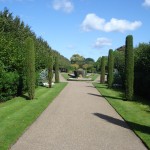
-
Regents Park
-
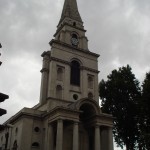
-
Christ’s Church
-
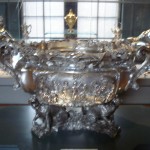
-
The Silver Exhibit in the V&A
-

-
Having a Good Time at the Fitzroy
Like many of my classmates I decided it would be worthwhile to summarize all of my discoveries this month in London. During this post I will focus on six main themes found within London: Parks, Churches, Pubs, Other Religious Institutions, Theatre and Museums.
Parks
Each park that I visited had its own distinct characteristics that separated it from any other. Green Park was the first I visited and after perusing a few others, I realized there was nothing that exciting about it. Located right across from Buckingham Palace, Green Park certainly provides a good place to go and take a break from the busy atmosphere of the area. Besides this however there is not much going on and I would recommend that potential park goers walk the extra distance over to St. James Park.
In addition to the large number of waterfowl heckling people for food which offers consistent entertainment St. James offers some picturesque flower beds throughout and various monuments along the way. It has the relaxing atmosphere of Green Park with a bit more excitement sprinkled in.
Regents Park offers a completely different feel from Green or St. James. Located in a separate area of London, Regents Park has a history of being used by a higher end crowd. I could tell this immediately from the feel of the park. The decorative shrubbery and elegant architecture throughout gave me a feeling that Regents is not as well used as other parks.
Since I was one of the members of the Parks group that gave a walking tour of Hyde Park and Kensington Gardens I could go into a lot more detail about these two green spaces but I will choose not to in an effort to be concise. In summary Hyde Park is the largest green space in London and is often used for larger events such as concerts, festivals etc. It also contains a large number of monuments throughout including the 7/7 memorial and the Diana Memorial Fountain. Kensington Gardens is home to a variety of key monuments but is not as well trodden as Hyde. Overall it makes for a quieter atmosphere, more conducive fo reading or “snogging”.
Regents Park were my two favorite green spaces in London. Regents, is both beautiful, and extremely large and I continually felt the need to go back and explore. Kensington Gardens appealed to me in that it was quainter than Hyde Park but contained a like amount of history and monuments throughout. Although I would be content spending a length of time in any London green space Regents and Kensington would be my top choices.
Theatre
Overall I enjoyed going to the theatre on so many occasions. What better place to do so than in London after all? Here I will discuss my favorite performances and theatre venues.
All in all I enjoyed all but two of the performances we saw. The two Shakespeare productions at The Globe Theatre were fantastic. Although I did not particularly enjoy reading Troilus and Cressida it made a huge difference to be there so close to the actors. The fantastic drum chorus at the end really sealed the deal. As You Like It was probably my favorite show I saw here in London. Although it is one of Shakespeare’s simpler plays the actors really made it jump off the page. Being down it the pit was fantastic because of all the ad-libbing and constant interaction with the crowd. I even felt traces of Touchstone’s saliva on my arm at one point.
The other Shakespeare performance I saw, All’s Well That Ends Well, was lackluster. Although the Olivier was my favorite performing venue (this is what an auditorium style theatre should be like…why can’t Dickinson have something like this?) the play itself was odd and ended on an abrupt and odd note.
The other play we saw at the National Theatre, The Pitmen Painters, was fantastic. Although I was dozing a bit because of the Benadryl I took right before the show, the actors kept my attention and I appreciated that the play was based off of a true story.
Easily the oddest play we saw was Arcadia. An extremely intelligent performance the play juxtaposed two different periods in time and created a singular storyline in which the plot was based. Overall it was an entertaining performance that made me think early and often.
Finally there was Blood Brothers. The lone musical I saw produced feelings of disbelief, anguish and held back laughter. The ridiculous 80’s sound track and creepy narrator just didn’t do it for me. I think it’s safe to say that I was not the only one from Humanities 309 who was a bit surprised to see just about everyone in the audience give it a standing ovation.
I had a very positive experience with the theatre here. I would go back to the globe again and again. I loved being that close to the action. I would also enjoy seeing another show in the Olivier. There really is so much to choose from here. It’s simply a matter of figuring out your tastes and saving your money so you can see a lot of performances.
Churches
From Westminster Abbey to St. Paul’s Cathedral we saw most of the major churches/cathedrals during our month in London. St. Paul’s was easily my favorite. From the fantastic crypt to the hundreds of stairs up to the tower it had so much to offer in the way of history and mystique. Westminster Abbey fascinated me primarily because of all the literary figures that had been buried inside as well as the room that was dedicated to “The Order of the Bath”. Other churches that I really enjoyed taking a look at were: “St. Martin in the Fields” which sits just outside Trafalgar Square and Nicholas Hawkesmoore’s “Christ’s Church” which is located in very close proximity to Brick Lane.
Other Religious Institutions
Overall the Sikh Gurdwara was my favorite place that we visited. I appreciated the simplicity of the religious doctrine as well as the conviction and honesty with which our tour guide, Mr. Singh spoke. The morning was capped off with a fantastic sit down meal together in which everyone was served the same food and drink.
I had different feelings about the Hindu Mandir. It was clear to me from the very beginning that the Hindu religion is not nearly as modest as Sikhism nor are they trying to be. From the extremely decorative prayer room, to the museum located right in the center of the Mandir I never felt particularly comfortable inside.
The only religious institution I wish we had gotten a chance to visit is a Mosque. I had been to one many years ago but I did not remember a whole lot from my experience. I wonder how much more lively the East End, and all parts of London would be if Ramadan were not taking place during our time here.
Museums
I could go on and on about museums so I will attempt to stay as concise as possible.
The British Museum was massive, convenient since it was so close to the Arran House but a little one dimensional at times. One of my favorite exhibits at the British Museum was a special exhibit on Living and Dying that drew information from all different time periods and cultures.
The National Gallery was fantastic. Although I have a hard time appreciating some visual art the gallery kept my attention for a number of hours. Seeing so many famous works of art was phenomenal.
The Tate Modern was my least favorite museum here. Although I am trying I have a hard time understanding modern art. After about 45 minutes in this museum it ended up being too much for me.
The Cabinet War Rooms/Churchill Museum were two of my favorites. The realization that I was standing in one of the most important places in World War II history was unbelievable. The War Rooms felt so authentic. I really felt as though I had been taken back in time to the 1940’s while inside.
The Victoria and Albert was easily my favorite museum in London. There was so much variety inside and so much to see. I could have easily spent a few days inside. Two of my favorite exhibits were the silver and jewelry exhibits. I’m not sure what this says about me as a person but I found it unbelievable that individuals could even own such treasures. I also enjoyed the laid back atmosphere of the V&A staff. At most of the other museums I visited I felt like I was doing them a disservice simply by being there. Although I understand that taking pictures of an object in a museum doesn’t do it justice I like to be able to have the option of doing so.
The Sir John Soane museum interested me but it wasn’t really my cup of tea in the end. It also had a stuffy atmosphere to it that I didn’t really appreciate.
One thing I can draw from my experience at museums here is that each and every one has something that distinguishes it. With so many museums I thought that it would be impossible to avoid some overlap but I never really felt that. Cheers to London and its museums.
Pubs
Finally we have pubs. What would London be without it’s public houses? In some cases pubs are the true museums of London, designating what an area was like in the past and what type of clientele it attracted. During my month here I had a chance to visit a few pubs and get a general sense of what some possible differences could be. It is clear to me that each pub brings something different and unique to the table. The Marlborough Arms was convenient being so close to the Arran House and was a great place to enjoy a pint over a meal with friends. The Court was conducive to socializing in a different way. The music was louder, the people louder and the drinks cheaper. Other places I visited offered other things that made them stand out as well. One thing that i’ve learned about pubs is that it’s hard for one to please everyone. Since everyone has different tastes and desires when it comes to pubs you are better off going to one with a small cohesive group.
To conclude this novel I would just like to say that I think we saw a lot of different faces of London this month. I realize there is much more to see here but between walking tours throughout the city, trips to major monuments and museums and individual exploration I have learned a ton about London, it’s history and where it is going. I look forward to more London explorations in the future but for now, ON TO NORWICH!
Tags: Churches and Cathedrals · Henry · Pubs · Theatre
September 14th, 2009 · No Comments
After spending a month in London and visiting a plethora of museums, they all are beginning to blur together in my mind. I have an easier time remembering specific pieces included in the museums that I loved rather than the overall museum itself, but I’ll try to relay my general sentiments of my final two destinations, the Sir John Soane and the Victoria and Albert Museums.
I felt that the Sir John Soane Museum was fascinating, but was distracted by how much was packed into such a small space. I wasn’t able to fully enjoy what I was looking at simply because I got a bit claustrophobic. On the flip side, though, it certainly was impressive how much was packed into the equivalent of three townhouses. One of my favorite aspects was the collection of clocks included in the house, because it reminded me of our trip to Greenwich and the importance of early timepieces. His particular collection stuck me because it really showed how clocks were once a symbol of status, specifically that which was made for Christopher Wren by Queen Anne.
Although the Sir John Soane Museum had interesting artifacts and art, I much preferred the Victoria and Albert Museum. My favorite section was the sculptures portion on the ground floor, and I spent a great deal of time exploring there. I enjoyed reading the captions to each, for example, a plaque under a bust of Albert Einstein stated that he was a culmination of “the humane, the humorous, and the profound.” Another statue, a monument to one Emily Georgiana, moved me in saying “I who dreamed wildly and madly/am happy to die.” The writing on that statue seemed simultaneously inspiring and sad, and I’ve thought of that quote often since reading it for the first time. My favorite actual work was a bronze piece created to hang above a fireplace depicting a nude man and woman entwined while being watched by a shocked and disgusted crowd. Made by Charles Sargeant, “Scandal” was interesting to me because it showed not only a couple in love (as many works do) but also the rarely shown negative reaction of the surrounding community. Lovers in art are so often isolated, so seeing a different perspective within the work was certainly interesting.
To summarize my previous blog entries regarding museums, I was unaffected by the British Museum, disliked the Tate Modern, moderately enjoyed the Cabinet War Rooms and Churchill Museum, and loved both the National Gallery and the Victoria and Albert museum.
Tags: Amy
September 13th, 2009 · 1 Comment
I had hoped that the Victoria and Albert would be something like the British Museum: large, but manageable. I was wrong. Entering the museum via underground tunnel, I was immediately confused as to where in the museum I was. Rather than the simplicity of rooms surrounding a central courtyard that all connected to each other, I was thrown into a maze of staircases, staff rooms, and an entire wing devoted to a cafe which took me several attempts to navigate around. By the end of my visit I was nearly too exhausted to make it back down the tunnel to the tube.
Don’t get me wrong, I did enjoy the museum. The fashion exhibit was, on entering, immediately next to me and it served as a good jumping off point, if not as amazing as I had been led to believe. However, a jaunt around the medieval section soon cheered me up quite a bit. The three story high room filled with plaster casts of ancient and gothic architecture made me particularly happy, especially the cast of Trajan’s column. I’ve studied this column, and I’ve seen pictures, but nothing is as amazing as standing next to it (despite the fact that it wasn’t the original). The sheer size and attention to detail made me dizzy. I had to consciously restrain myself from touching it. After drooling over it for a few minutes, I attempted to enter the other room of casts (in which was housed what looked like a cast of the Colossus of Rhodes), but was thwarted by scaffolding and a sign saying “observe from third floor balcony”. In my search for this mythical balcony I ascended some stairs and turned some corners and got lost. Very lost. So lost that I rounded a corner thinking “how will I ever get out of here and where the hell am I supposed to go next”. Luckily the gods seemed to hear me and deposited me in a safe haven for people like me: the Theater exhibit.
I loved the theatre exhibit, especially the dress-up box of costumes to try on (yes, I’m a geek, but what can I say, it was COOL!). The miniature set models were so well done, and the model of the Theatre Royale at Drury Lane almost sent me into convulsions. Its attention to detail was fabulous, from safety posters to the raked stage, to little men being raised through little trap doors. It gave a wonderful history of theater in London from about 1900 onward, and the exhibit was so interactive that I spent a good 45 minutes in it, and it’s really not that big. However, I eventually found my way out.
It then, however, took me another half an hour to find my way back to the subway. As much as I did enjoy the experience, the museum is trying to do too much at once. Instead of focusing on one type of exhibit or one time period or one country, it has crammed them all into a maze of rooms, leaving the visitor with the feeling of being beaten over the head with a textbook (albeit an interesting one) upon leaving. I think it would be a much more effective museum if it divided its exhibits up into different buildings. It has already separated the Childhood museum from the main one, so why not do it with more? They have enough exhibits in there to house hundreds of museums. Why cram it all into one?
Interestingly, I didn’t find the British Museum exhausting (or at least not as exhausting). Perhaps I find the way the rooms are organized more understandable, or the fact that most of it is linked to archaeology (or in the case of the Parthenon Marbles, stealing in the name of archaeology). The British Museum is not as large an amalgam of ideas as the V&A. The exhibits on ancient Rome and Greece, Assyria and Egypt, and even North America, they are all connected under the tent of archaeology and anthropology. The only problem I have with the museum is its questionable acquisition techniques (most of which have been pointed out to me by Professor Maggidis, so perhaps I am a little biased in favor of the Greeks).
However, I think the hodgepodge of artifacts in both these museums parallels the mishmash of cultures living in London brilliantly. The names “British Museum” and “Victoria and Albert” evoke very nationalistic images, but house such a variety of things, much like modern London. While neither museum specializes in Bangladeshi artifacts or Jewish culture, the fact that they do house so much of non-traditional English stuff shows just how diverse England would like to be. Its next step is to realize the abundance of cultures it already has, and perhaps show those off a bit too.
Tags: Campbell
September 13th, 2009 · No Comments
In case my portmanteau skills are just too much to handle, this post is a combined reflection of my overall museum experience here in London. I am splitting it into two parts so Karl doesn’t fall asleep 1000 words into the post. Enjoy!
Cabinet War Rooms
I have never been one for history class, since the present and future have always been much more interesting to me than the past. I do appreciate how important it is to learn and understand the past because I believe that time is cyclical in nature (another topic for another time, probably a class on Nietzsche). My experience in the Cabinet War Rooms turned my opinions upside down. Never before have I been so enthralled by the events of yesteryear. The museum did a fantastic job of immersing me into what truly felt like World War II era Britain. Because the bunker was so impeccably preserved, it really felt like Prime Minister Churchill was actually working, chain smoking cigars a few rooms down from me while top-level officers made encrypted phone calls to top secret locations. The sense of urgency was palatable. Beginning in 1940, the Germans started working on Operation Sealion, a full-scale invasion of the UK. Looking into the rooms where crucial decisions were made gave me a real sense of anxiety. Will the invasion really happen? Will it be next week, or even later today? How can we prepare a country of millions against one of the most powerful forces in the world? All these questions were dealt with directly exactly where I was standing. It’s hard to fathom how much pressure was felt by Mr. Churchill at any given time throughout those six, unbearably tense years. Remarkable.
What made me happiest was the sense of humor Churchill and crew managed to maintain throughout the war. Take the map room, a very sparse and serious quarters where some of the most important decisions of this country’s history were made. Right smack in the middle of the Pacific Ocean away from all the action (and any landmass) was some bored officer’s caricatured sketch of Adolf Hitler. I wish I hadn’t forgotten my camera, because it was such a hysterical juxtaposition of absolute seriousness and absurd humor. In another important room was a huge clump of multicolored telephones that the officers endowed with the appellation “The Beauty Chorus.” Instances like these support my philosophy that there is humor to be found in every situation, but again, another topic for another time.

http://www.surbiton-probus.org.uk/images/Cabinet-War-Rooms.jpg

http://www.ahoys.com/blog/wp-content/uploads/2009/05/cabinet-war-rooms.jpg
Victoria and Albert Museum
The V&A is exactly the type of museum I can’t stand. Again, the past tends to bore me in the face of the present, and looking at minutia such as plates and vases from X number of years ago is about as exciting to me as, well, you get the idea. This museum was stuffed to the gills with the riff-raff of ancient civilizations. The layout didn’t help very much either. Each civilization has its own section, ranging from the vast, sprawling “17th Century Europe” section, to the disappointingly diminutive Korea exhibition, brought to you by Samsung.
After some mindless wandering, I decided that the best way to overcome my ennui was to immerse myself in a culture totally unfamiliar. I chose Japan on the basis that samurai are really cool, admittedly. After about an hour of exploration, I found myself to be pleasantly surprised. They had an interesting display of Noh garb. Noh is a form of Japanese drama popularized during the 14th Century. It is most interesting because of its parallels with Zen Buddhism. It complies with Zen’s principles of “restraint, understatement, economy of movement, and frugality of expression,” as noted by the exhibit. The minimalistic plays involved very little movement on the part of the actors, few if any props, and absolute austerity. In stark contrast to the scant nature of the acting, performers wore Noh masks. Each mask represents a different emotion. The following masks were on display (All images from www.nohmask.com, except for Okina, found at http://www.artsci.wustl.edu):
Hannya, a woman turned demon representing jealousy.
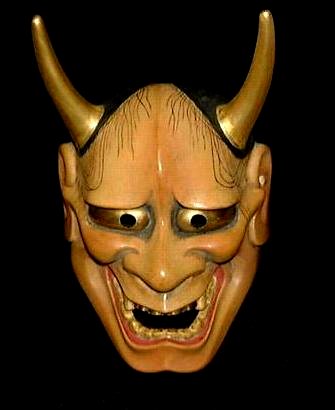
Hannya
Waka-Onna, a young woman symbolizing beauty and nobility.

Waka-Onna
Shikami, expressing violence.
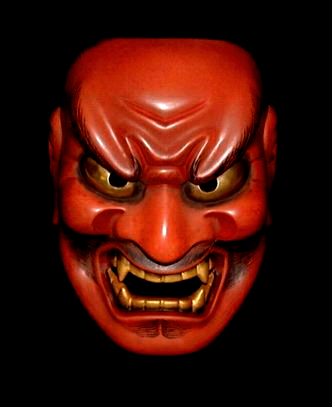
Shikami
Uba, who represents a once beautiful woman.

Uba
Okina is most interesting. He is the oldest representation in the Noh repertoire. He symbolizes agricultural fertility, and is the only mask that actors don after entering the stage.

Okina
Overall, the Japan exhibit was the only one that piqued my interest. Noh is fascinating and is definitely worth further researching.
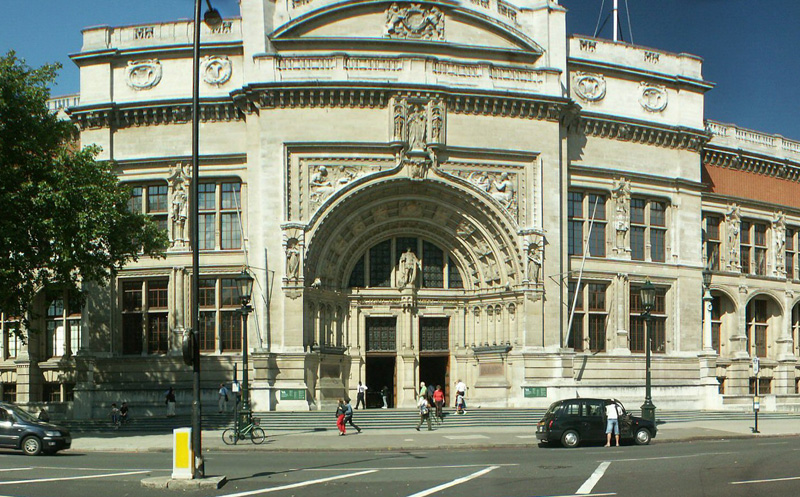
http://farm1.static.flickr.com/91/271297653_670230dee1_o.jpg
Stay tuned for part 2, featuring the British Museum, National Gallery, and more!
Tags: Andrew B
September 10th, 2009 · 2 Comments
I had a huge problem with the Victoria and Albert Museum. Maybe that’s not the most gracious of ways to begin a post but it’s the only way that seems fitting. I was really excited to go to the museum. Not only had I heard only rave reviews from my classmates but I had also been introduced to just a taste of all the many ways that Victoria and Albert aided the arts and science communities on our very first day here on our tube stop adventure. I was expecting a museum that displayed some of the finest collections of art-sy and science-sy things shown off in an almost magical way. What did the museum show me though? Wedding dresses. The only thing I remember from all of the exhibitions is the fashion room. Maybe that wasn’t the best room for a person like me to go into (I’m not the best at coordinating colors and prints but, in my defense, I at least know that plaid and stripes don’t go together). Still, I think that a person without the least bit of fashion sense should be able to go into an exhibit in this type of museum and not come out with a feeling of outrage. Now, I have been researching feminist literary figures in the Bloomsbury area for the past week so maybe I’m a bit more sensitive to gender issues than I might normally be. That being said, the fashion room was laid out in a way that seemed to make the statement that the epitome of female dress could be found in a wedding dress. I don’t know if I’m alone in this sentiment but that statement couldn’t be more belittling or insulting. In my mind, glorifying a wedding dress in this way fits into the mindset that women are to only aspire to be a wife. I have nothing against marriage and think that being a stay-at-home-mom is quite a respectable position in life. But to be limited to such a role is wrong and it is exactly that limitation that I feel the fashion room in this museum was advertising.
Women have for years been actively pursuing equal opportunities in the workplace and home alike. Many women from the London area made great strides in assuring these opportunities came about. In the literary world, Virginia Woolf, George Eliot, Vera Brittain, Jane Austen– these are just a few of the women who pushed their way to the forefront of the literary world and showed that women had as much talent as men and should be given the opportunity to showcase that talent. Other influential women such as Millicent Garrett Fawcett, Sylvia Pankhurst, and Nancy Astor also have an important influence in the city. Let’s not forget that some of the most memorable sovereigns of the nation were women. Queen Elizabeth I, Queen Elizabeth II, and even Queen Victoria herself made contributions to the well being of the nation that cannot be overlooked. Though incredibly diverse in their many accomplishments, all of these women have one thing in common: their lives amounted to more than a wedding dress.
The Victoria and Albert Museum seems to ignore the rich history of powerful females in London though and, instead, caters to the idea that the aspiration of women is to look good on their wedding day. I think this is most clearly demonstrated in the wedding dress by Neymar that was worn by Angela Stamp on their wedding day in 1976. It was designed to resemble something Anne Boleyn would have worn.
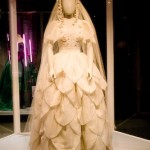
Angela Stam's Neymar wedding dress
Anne Boleyn used marriage as a social stepladder more than possibly any other woman in history in my opinion. Taking any connection to the dress’s primary influence away though, the dress itself showcases exactly what the feminist movement was rebelling against in the 1970s. It is embroidered with beads and flowers and covered in frills and folds is such a way that it emphasizes the dress not the woman. In fact, the mannequin on display has absolutely no facial attributes at all. The woman is literally unnecessary. To me this implies that any woman can be placed into this dress, it wouldn’t matter at all who is in it. The dress is going to serve its purpose. The dress is going to find the desired husband (the husband who wants his wife in such a dress and will pay to make sure she looks like this to her public). Yes, it is crafted beautifully and is truly a sight to see. Other dresses were just as beautiful though, but it was this dress along with two other wedding dresses that were on display in single cases. It was this dress along with two other wedding dresses that attracted everyone’s attention. The museum is compiling a collection of wedding dresses for their wedding dress exhibit in 2013. It’s currently 2009. These wedding dresses aren’t a part of that exhibit. These wedding dresses are a part of the everyday collection and as such send the message (at least to me) that these are important enough to be set aside from all the other dresses because they are the most important clothes that women can ever put on. I would argue that’s just simply not the case.
I’m not even going to get started on the significant lack of male clothes present in the exhibit. There was a case of suits in the entire room. That was it. I recognize that that inequality is also a problem but the message of limitation through the wedding dresses was what struck me most in the room. Again, I was excited about seeing the museum. Victoria and Albert made incredible contributions to the art and science communities that shouldn’t be ignored. Unfortunately, the way in which the wedding dresses were displayed made all of their accomplishments completely invisible to me. All I could see was lace and embroidery.
Tags: Audrey · Museums



















